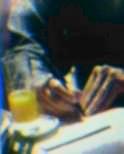Return to the Heart
Reunions are powerful occasions, and I will always treasure the one I experienced a year ago between my wife and her daughter, Pamela. Pamela had been adopted shortly after her birth, and through her first 21 years she had never met her natural mother. Pamela arranged a meeting, and their reunion was a very moving event. Like her mother, Pamela is a very beautiful woman, and I only hope that this music reflects her beauty, courage and grace.
Near the Still Waters of Amsterdam
A walk through the city late in the day, when all the buildings were aglow with the sunset's reflection, captured the mood of this piece. It was one of the first recordings we made in Europe and, like the others, it was done in a very relaxed environment.
Madre de la Tierra
The title literally means "mother of the earth," and the music was originally written to commemorate the 20th anniversary of Earth Day. It should remind us that we live on a beautiful planet, and we need to give Mother Nature all the love, care and respect she deserves.
Sounds from the Koepel
Hearing the reverberation of the piano in the space under the Koepel's giant dome was very inspirational. As I played, the music seemed to spiral upwards into the pattern of the dome.
Heartsounds
Heartsounds is the title song of my first recording, so this will always remain a special piece to me. The music is my impression of a light, contented heart. Through the years it has become an improvisation in my concerts, and it has evolved in many ways. This is its European interpretation.
Mañana, mi amor
It was 4 o'clock in the morning. Too late, too hot, almost too relaxed to record. Yet the conditions turned out to be perfect in the Palacio de Gaviria's ornately decorated "Sun Room," capturing the spirit of "mañana."
Corre, río, corre (Run River Run); Medley:
Behind the Waterfall/Desert Rain
All three of these pieces fall into what I have referred to as my "water phase," a phase which continues to influence much of my music. One of the beautiful rivers of the Pacific Northwest inspired Corre, río, corre. All three, in fact, were inspired by the movement of water, and I found it interesting that all were recorded in the driest acoustical setting of the four we used.
Friedensengel (Angel of Peace)
Before recording this improvisation, I sat at the piano and meditated on the feeling of quiet reverence. I feel that this music best conveys the more spiritual message of RETURN TO THE HEART.
A Whiter Shade of Pale
(MIDI courtesy T. Norman)
This remains one of my favorite pieces from any period of music. It seemed fitting to record this version in Germany, since rock historians attribute its inspiration to a piece originally composed by J. S. Bach.
Heart of the Night
An improvised prelude to Dream of the Forgotten Child, I felt a soft darkness gathering around me as I played.
Dream of the Forgotten Child
(MIDI courtesy C. C. Contreras)


